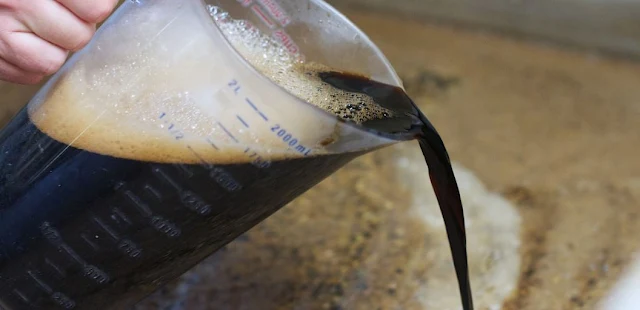Guide to make really good beer wort for home brewing
When I first started making beer I was totally confused by the word 'wort' that I kept seeing everywhere."Cool your wort quickly!" the internet said.
Um what?
This is to extract the bittering, flavour and aroma from hops. This is critical if you want your beer to have the characteristics of beer!
Image credit to Alan Levine via Creative Commons Licence
Well know I know, it's clear that 'beer wort' is the starting point for making beer. It is the amber liquid extracted from malted barley.
In the most basic sense, you can describe the wort as unfermented beer.
In the most basic sense, you can describe the wort as unfermented beer.
Beer makers use the wort as the basis to which start the beer.
Think of the wort as the base contents of the potion in a witch's cauldron.
As the witch adds 'eye of newt' and other goodies to her potion, the beer maker does the same by adding flavourings and hops to the wort to prepare a solution ready for fermenting. Like a painter needs a well prepared canvas, the wort is the same building block for making great beer.
As the witch adds 'eye of newt' and other goodies to her potion, the beer maker does the same by adding flavourings and hops to the wort to prepare a solution ready for fermenting. Like a painter needs a well prepared canvas, the wort is the same building block for making great beer.
Kinda
Like making a cake, if you don't use the correct ingredients in the right proportions your cake fails, a wort needs to be properly prepared.
If you are making beer using a beer kit, then your wort is easily made simply by adding the content of the can to the required volume of hot water.
Boom, you have wort.
If you are making beer using a beer kit, then your wort is easily made simply by adding the content of the can to the required volume of hot water.
Boom, you have wort.
You then add to your beer potion, hops, and sugars such as dextrose or a beer enhancer.
If you're boiling your own wort, it's more complicated. You the one who is in charge of making sure you have all the ingredients and that you boil the hops at the right timings - this is crucial if you are trying for a specific kind of bitterness - so make sure you have the right gas burner to get your wort to a hot temperature.
Mashing is required to turn the grains into sugars. The grains a mixed with malt and hot water for an hour or so in a mash tun. When the liquid is ready, it is 'sparged' from the mash and ready to be boiled.
Mashing is required to turn the grains into sugars. The grains a mixed with malt and hot water for an hour or so in a mash tun. When the liquid is ready, it is 'sparged' from the mash and ready to be boiled.
This is to extract the bittering, flavour and aroma from hops. This is critical if you want your beer to have the characteristics of beer!
The bittering hops are usually boiled in the wort for approximately one hour to one and a half hours. This long boil extracts resins from the hops which provides the bittering.
Near the end of the boil, flavouring hops can be added. Then, if you're fully on your beer brewing game, finishing hops are added last. This part of the wort boil extracts the oils which provide flavour and aroma.
are added last. This part of the wort boil extracts the oils which provide flavour and aroma.
Near the end of the boil, flavouring hops can be added. Then, if you're fully on your beer brewing game, finishing hops
Chill out, man
Once your wort is boiled it's now time to sparge the wort - that means to drain it from the grain mash.
and everything has gone to plan, the wort is chilled very quickly using a wort chiller.
Due to the temperature requirements of yeast, it needs to be at a temperature which will allow it to thrive. If you put your yeast into the extremely hot boiled wort, you will kill the yeast and get flat beer.
It might taste nice but there won't be any alcohol in it either!
Brewers have a tough enough time trying to work out if their beer has fermented properly, so make sure you get that part of your beer brewing right!
and everything has gone to plan, the wort is chilled very quickly using a wort chiller.
Due to the temperature requirements of yeast, it needs to be at a temperature which will allow it to thrive. If you put your yeast into the extremely hot boiled wort, you will kill the yeast and get flat beer.
It might taste nice but there won't be any alcohol in it either!
Brewers have a tough enough time trying to work out if their beer has fermented properly, so make sure you get that part of your beer brewing right!
Here's some New Zealand classic beer clone wort recipes you might like:
















0 comments:
Post a Comment